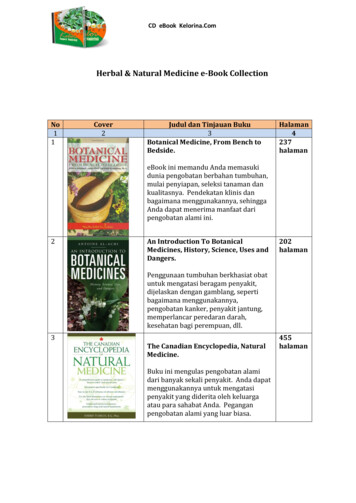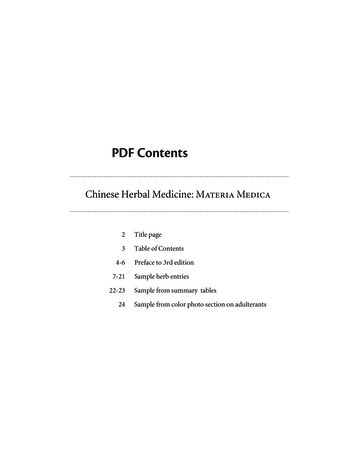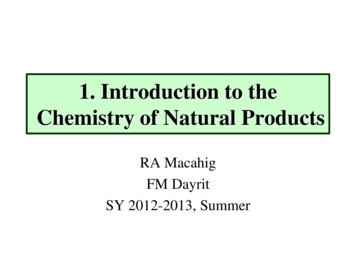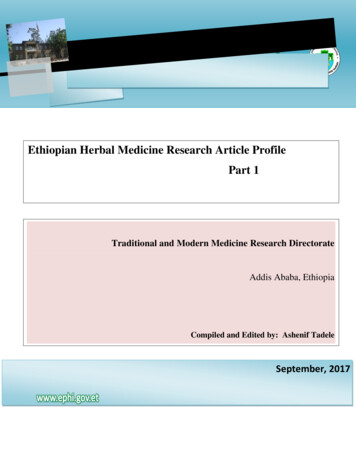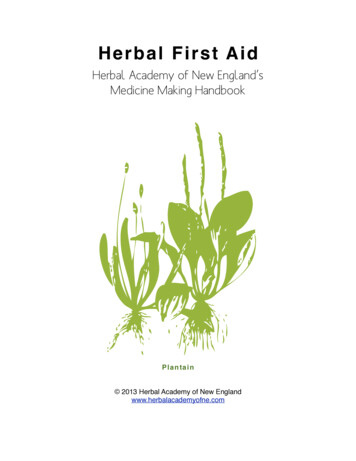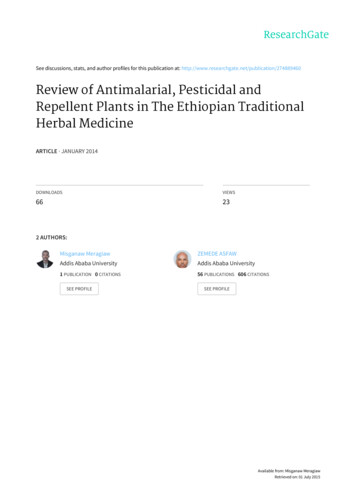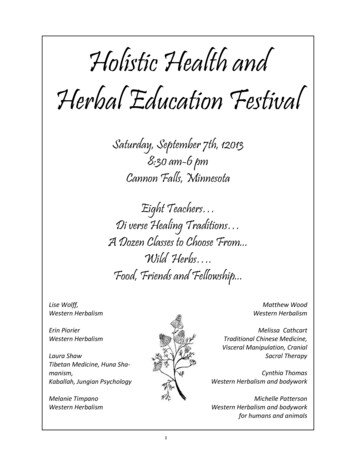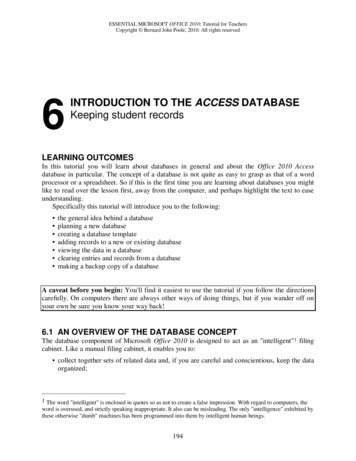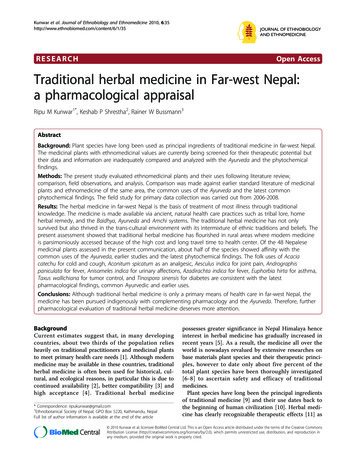
Transcription
Kunwar et al. Journal of Ethnobiology and Ethnomedicine 2010, AL OF ETHNOBIOLOGYAND ETHNOMEDICINERESEARCHOpen AccessTraditional herbal medicine in Far-west Nepal:a pharmacological appraisalRipu M Kunwar1*, Keshab P Shrestha2, Rainer W Bussmann3AbstractBackground: Plant species have long been used as principal ingredients of traditional medicine in far-west Nepal.The medicinal plants with ethnomedicinal values are currently being screened for their therapeutic potential buttheir data and information are inadequately compared and analyzed with the Ayurveda and the phytochemicalfindings.Methods: The present study evaluated ethnomedicinal plants and their uses following literature review,comparison, field observations, and analysis. Comparison was made against earlier standard literature of medicinalplants and ethnomedicine of the same area, the common uses of the Ayurveda and the latest commonphytochemical findings. The field study for primary data collection was carried out from 2006-2008.Results: The herbal medicine in far-west Nepal is the basis of treatment of most illness through traditionalknowledge. The medicine is made available via ancient, natural health care practices such as tribal lore, homeherbal remedy, and the Baidhya, Ayurveda and Amchi systems. The traditional herbal medicine has not onlysurvived but also thrived in the trans-cultural environment with its intermixture of ethnic traditions and beliefs. Thepresent assessment showed that traditional herbal medicine has flourished in rural areas where modern medicineis parsimoniously accessed because of the high cost and long travel time to health center. Of the 48 Nepalesemedicinal plants assessed in the present communication, about half of the species showed affinity with thecommon uses of the Ayurveda, earlier studies and the latest phytochemical findings. The folk uses of Acaciacatechu for cold and cough, Aconitum spicatum as an analgesic, Aesculus indica for joint pain, Andrographispaniculata for fever, Anisomeles indica for urinary affections, Azadirachta indica for fever, Euphorbia hirta for asthma,Taxus wallichiana for tumor control, and Tinospora sinensis for diabetes are consistent with the latestpharmacological findings, common Ayurvedic and earlier uses.Conclusions: Although traditional herbal medicine is only a primary means of health care in far-west Nepal, themedicine has been pursued indigenously with complementing pharmacology and the Ayurveda. Therefore, furtherpharmacological evaluation of traditional herbal medicine deserves more attention.BackgroundCurrent estimates suggest that, in many developingcountries, about two thirds of the population reliesheavily on traditional practitioners and medicinal plantsto meet primary health care needs [1]. Although modernmedicine may be available in these countries, traditionalherbal medicine is often been used for historical, cultural, and ecological reasons, in particular this is due tocontinued availability [2], better compatibility [3] andhigh acceptance [4]. Traditional herbal medicine* Correspondence: ripukunwar@gmail.com1Ethnobotanical Society of Nepal, GPO Box 5220, Kathmandu, NepalFull list of author information is available at the end of the articlepossesses greater significance in Nepal Himalaya henceinterest in herbal medicine has gradually increased inrecent years [5]. As a result, the medicine all over theworld is nowadays revalued by extensive researches onbase materials plant species and their therapeutic principles, however to date only about five percent of thetotal plant species have been thoroughly investigated[6-8] to ascertain safety and efficacy of traditionalmedicines.Plant species have long been the principal ingredientsof traditional medicine [9] and their use dates back tothe beginning of human civilization [10]. Herbal medicine has clearly recognizable therapeutic effects [11] as 2010 Kunwar et al; licensee BioMed Central Ltd. This is an Open Access article distributed under the terms of the Creative CommonsAttribution License (http://creativecommons.org/licenses/by/2.0), which permits unrestricted use, distribution, and reproduction inany medium, provided the original work is properly cited.
Kunwar et al. Journal of Ethnobiology and Ethnomedicine 2010, 6:35http://www.ethnobiomed.com/content/6/1/35well as some toxic side-effects [12]. Thus, Nepalesemedicinal plants with ethnomedicinal properties arebeing screened for their active pharmacological effects[13]. The present study therefore evaluated the ethnomedicinal uses of the selected 48 second priority medicinal plants of Baitadi, Dadeldhura and Darchula districtsof far-west Nepal and comparatively assessed their usesagainst earlier standard literature on medicinal plants ofthe same area, the common uses of the Ayurveda (anancient traditional system of herbal medicine in theHimalaya) and the latest phytochemical findings.Materials and methodsThe field study for primary data collection was carried outin the Baitadi, Dadeldhura, and Darchula districts of farwest Nepal from 2006-2008. The districts stretch between29 01’ and 30 15’N latitude, 80 03’ and 81 09’E longitudeand 357 m - 7132 m altitude. The study sites were Anarkholi, Dasharathchand, Jhulaghat, Khodpe, Kulau, Pancheswor, Patan, Salena, and Sera (Baitadi); Brikham, Jakh,Jogbudha, Patram, and Rupal (Dadeldhura), and Dumling,Figure 1 Study site: Khar VDC, Darchula district.Page 2 of 18Gokule, Joljibi, Khalanga, Khar (Figure 1), Lali, and Uku(Darchula). All three districts are situated along the western borders of the country and lie adjacent to India. Dueto variations in altitude, topography, and bio-climatewithin the districts, the diversity of medicinal plants andknowledge of utilization are vast. The subsistence use isprofound particularly for home herbal healing [5,14].There are a number of diverse ethnic groups in the area.The largest ethnic group is the Chhetri (more than 50%),followed by Brahmin (about 20%), Dalits (about 10%),Thakuri (7%), Magar (2 %), and a few other groups. Thefirst two groups are considered privileged and the rest areconsidered ethnic (Janajati) and disadvantaged (Dalits).Ethnic and disadvantaged groups have easy access opportunities provided by the government.Field surveys and data collectionFour field surveys were carried out during different seasons of the year (May, December 2006, February 2007,March-April 2008). Each survey lasted over 20 days inthe field. Primary data collection, after establishing oral
Kunwar et al. Journal of Ethnobiology and Ethnomedicine 2010, med consent with the participating communities,consisted of group discussions, informal meetings, schedule surveys, key informant surveys, cross-checking, andfield observations. In all surveys, four group discussionsand six informal meetings were held; in total 172 individuals were consulted. Informal meetings were held invillages while staying with them. The traditional healers(Baidhyas) and women representing major ethnicgroups, castes, and occupations were encouraged to participate. Baidhyas are traditional medicinal practitionersparticularly of the western Nepal mid-hills [15] andadjoining areas of India [16]. Women were active participants of the informal meetings. Among the respondents, 3% were traditional healers, 12% were ethnicgroups, and 21% were women.All plant species encountered during field observationswere recorded. Medicinal plant species were collectedduring the day and displayed during evening meetingsfor discussion. Both the collections and surveys/discussions were facilitated by local assistants, and the information was sought about vernacular dialects, indigenoususes of the species and participants’ priority on species.Ranking was followed to categorize the first, second andthird priority medicinal plant species. The speciesenumerated in the present study were the second priority medicinal plants of the local communities with informant consensus factor less than 0.85. The first prioritymedicinal plants with quantitative ethnomedicine werealready discussed [14,17].Matching information from at least three respondents(mentions) was counted as a common response for theanalysis. The single most common folk use of each species was valued for further discussion. Common speciesand mono specific genera which were well known bytheir dialect names were used only for discussion andnot managed as voucher specimen for further identification. Voucher specimens were collected, and vernacularnames and folk uses were recorded for each specimen.Specimen collection was made following Cunningham[18], and plants were identified to species level. Most ofthe species were identified in the field using literature[19,20]. The remaining unidentified species were identified and housed in Kathmandu at Tribhuvan UniversityCentral Herbarium (TUCH), Department of Botany,Tribhuvan University, Nepal.The observations of the present survey were comparedto earlier observations, latest common phytochemicalfindings and common uses of the Ayurveda. The common uses of the Ayurveda were taken from the following literature [21-27]. Literature [28-33] of Nepal wereused as reference for earlier ethnomedicinal informationof the same area. Pharmacological information wasretrieved from internet sources (available till June, 2010)and relevant journals; most of them were accessed fromPage 3 of 18USA. About 240 research papers and articles werereviewed for analysis.Results and DiscussionTraditional herbal medicineTraditional herbal medicine has been used since ancienttime in many parts of the world where access to formaland modern healthcare is limited. Nepal is not exemptand in mid-hills, mountainous and rural areas of thecountry where access and services are limited, herbalmedicine is the basis of treatment of most illnessthrough traditional knowledge. It is estimated thatapproximately 90% of the Nepalese people reside inrural areas where access to government health care facilities is lacking [30]. These people rely predominantly ontraditional herbal medicine. Traditional medicine ismade available via ancient, natural health care practicessuch as tribal lore, home herbal remedy, and the Baidhya, Ayurveda and Amchi (traditional healing system ofTibet and mountain areas of Nepal) systems. The former one is innate to the tribal group (i.e. Raute in studyarea) [34]. Home herbal remedy and the Baidhya systemare indigenous to far-west Nepal [14,15] and are partlyinfluenced by the Ayurveda [35]. Extant of home herbalremedy in far-west Nepal is also due to relatively homogenous resource users and less encroachment fromimmigrants. Home herbal remedy and Baidhya system,yet transformations of the Ayurveda, are well establishedand practiced in the study area. The Amchi system iswidely accepted and practiced throughout high altitudeareas of Nepal [10] and is important in Darchula district, albeit with some modifications [29].As communicated by Kunwar et al. [17], the knowledge base for traditional herbal medicine stems fromspirituality, customs, livelihood strategies and availablenearby resources. Medicinal herbs are main ingredientsof traditional herbal medicine, and the traditional herbalmedicine is considered as the main lifeline [36], the firstchoice [37], fewer side-effects, better patience tolerance,relatively less expense, and cultural acceptance and longhistory of use, in comparison to western medicine.Thus, the traditional herbal medicine has not only survived but also thrived in the trans-cultural environmentwith its intermixture of ethnic traditions and beliefs.Most of the time, this knowledge is passed on orally andtherefore is endangered. Particularly the Amchi knowledge is passed down through dedicated apprenticeshipsunder the tutelage of senior Amchi [38]. Although traditional herbal medicine is effective in treatment of various ailments with considering ritual and socio-culturalcustoms [39], very often the medicine is used indigenously with indifference to the scientific knowledge andtheir possible side effects were overlooked. The dearthof reports of adverse effects and interactions probably
Kunwar et al. Journal of Ethnobiology and Ethnomedicine 2010, ct a combination of under-reporting and the benignnature of most herbs used [40]. Therefore, the traditional herbal medicine deserves a great scope of researchin the light of modern science.The present assessment showed that traditional herbalmedicine has flourished in rural areas where modernmedicine is parsimoniously accessed as a result of thehigh cost and long travel time to health center. Moreover inadequate modern medical resources/facilities andgovernment subsidies also made traditional herbal medicine pertinent in Nepal. It is estimated that there is onephysician for every 20,000 people whereas there is morethan one healer for every 100 people in Nepal [41,42].Herbal medicine prescribed by healers is either preparation based on single plant part or a combination of several plant parts. However, we dealt only the primary onefor further discussion in the present study. Many of theplants most often used in study area to treat ailmentsare also commonly used all over Nepal. Particularly theethnic groups and scheduled caste are the major stakeholders of the traditional herbal medicine [43], so, traditional medicine is still the mainstay of health care in therural areas of Nepal where the majorities of the denizensare from ethnic groups and scheduled castes.Medicinal plants and their usesOf the 48 species from 46 genera and 40 families (Table 1)discussed in the present study, indigenous uses of about70% species resembled to the earlier ethnomedicinalreports. The indigenous uses of about 50% species hadaffinity to the Ayurveda, and about 40% species werefound to have efficacy in pharmacology. Fabaceae, Moraceae and Rosaceae were represented by the greatest number of species (3 each), followed by Euphorbiaceae andLamiaceae (2 each) for herbal medicine in study area. Atotal of 30 ailments were reported in the present study,and among these inflammation, cuts & wounds, diarrhea& dysentery and fever were considered as common, andthe maximum number of medicinal plant species wereused against, six species to each category and four for thelatter. Similar observation of maximum number of speciesused for fever and cuts & wounds was reported by Manandhar [34]. The plant parts used for herbal remedies werebark, flower, fruit, leaf, milk/latex, root/rhizome, seed,shoot, wood, and the whole plant. Plant parts root/rhizome, leaf, and fruits, etc. were most frequently utilized.PharmacologyThe results obtained support prior observations, pharmacology and Ayurvedic uses concerning the followingspecies: the crude extracts of Acacia catechu for coldand cough, Aconitum spicatum as analgesic, Aesculusindica for joint pain, Andrographis paniculata for fever,Anisomeles indica for urinary affections, AzadirachtaPage 4 of 18indica for fever, Euphorbia hirta for asthma, Taxuswallichiana for tumor control, and Tinospora sinensisfor diabetes. This probably explains the use of theseplants by indigenous people against a number of infections as transcend from transcultural environment withfollowing home herbal remedy, Ayurveda and Baidhyasystems. It is known that the families Rutaceae andMeliaceae are among the richest and most diversesources of secondary metabolites among the angiosperms [44], and the species of Meliaceae are known tohave intense antimalarial characters due to highly oxygenated terpenoids [45]. Use of leaves of Azadirachtaindica (Meliaceae) as antipyretic is widely used in studyarea (Table 1) and throughout Nepal [46] was substantiated by the nimbidin flavonoids [47,48]. Oleic acid andgedunin of A. indica are also reported to be an in vitroantimalarial [49-51]. Other species contributed as antipyretic in home herbal remedy in study area wereAndrographis paniculata (Acanthaceae), Aconitum spicatum (Ranunculaceae) and Osmanthes fragrans(Oleaceae).Andrographolide and neoandrographolide from Andrographis paniculata own anti-inflammatory activity[52,53]. Its diterpene exhibits antioxidant and hepatoprotective properties [54-57]. Immunostimulant [58],antibacterial [59], analgesic [60] and antiprotozoal [61]characteristics of A. paniculata extract have also beendemonstrated. These values probably explain the use ofA. paniculata by the indigenous people against a numberof infections and fever. Crude root extract of Podophyllum hexandrum (Berberidaceae) was used as hepatoprotective, despite the hepatotoxic character reporteddue to its lignans [62]. Podophyllotoxin has manifestedantimitotic activity and capability of inhibiting DNA,RNA and protein synthesis [63]. There were seven species in study area exhibiting hepato-protective effects.Among them, six were pharmacology based and threewere folkloric. Plant extracts of P. hexandrum andAndrographis paniculata showed hepato-protective characters consistent with the folk use and pharmacology.Alkaloids are most common in flowering plants, especially in Fabaceae, Ranunculaceae and Solanaceae [64].Some alkaloids (aconitine, anisodamine, berberine,charantine, leurosine) show antidiabetic effects [65]. Berberine of Tinospora sinensis (Menispermaceae) is antidiabetic [66-68], but higher doses may be antagonistic [69],which strongly support the folkloric use of the plantextract. According to Marles and Farnsworth [70], thereare about 1,000 species of plants that can act as an antidiabetic and approximately 80% of these are used in folkherbal medicine. Antidiabetic reports of Azadirachtaindica, Carum carvi, Tinospora sinensis and Vitexnegundo stated in the present communication were
Kunwar et al. Journal of Ethnobiology and Ethnomedicine 2010, 6:35http://www.ethnobiomed.com/content/6/1/35Page 5 of 18Table 1 Major uses of the medicinal plants, their chemical constituents, and latest common pharmacological findings(species are in order of references)SN Scientific name,local name, familyand voucher codeFolk use found Major folk uses inin presentprevious studiessurveyMajor uses in theAyurvedaSelected major chemicalconstituentsLatest commonpharmacologicalfindings1. Lobelia pyramidalisWall. CampanulaceaeLobelia (E), Aklebir (N),Eklebir (S), 569/00.Syn. L. nicotianaefoliaRothJuice of leavesand flowers isrubbed onbody partsduring bodyache.Leaves andinflorescence areantispasmodic [30] andused for asthma,bronchitis and fever[31].Leaves and flowersLobeline, radicamine.are antispasmodicand they are used asan expectorant. Plantis used for sciatiaand back pain [21].Lobeline may causenausea, vomiting anddiarrhea [38].2. Cannabis sativa L.Cannabaceae Hemp(E), Ganja (N), Bhang(S).Syn. C. indica Lam.Leaf juice isapplied tocontrolbleeding.Leaf juice is useful forhealing wounds,control bleeding andstomachache [32].Plant is efficaciousCannabigerol, cannabidiol,for diarrhea. It is also friedelin, lectins [32].used asantispasmodic [21]and sedative [25].Leaves are used assnuff for smoking andare given internally torelieve pain andswelling [27]. Lectinspossess haemagluttinating properties[38].3. Scutellaria discolorColebr. LamiaceaeRatpatya (L), Dampate(N) KU 07263.Syn. S. indica BlumeWhole plantPlant juice is useful forand leaf paste is headache and feveruseful for cuts[28] and woundsand wounds.healing [30].Plant juice is usedfor rheumatism[147].Root juice is given inindigestion andwogonin exertsanxiolytic effects [135].Plant and root extractis used for rheumatism[136].4. Ficus palmataForssk. MoraceaeBedu (N).Syn. F. virgata Wall.Plant milk isuseful for takingout the thornsfrom wounds.Plant latex is used toFruits are taken forFriedelin, tannins.expel the spines [30].lungs disorders [147].Fruits are used forconstipation, lungs andbladders diseases [33].5. Grewia dispermaRottb. TiliaceaeViywal (L), Syalpuchre(N).Syn. G. serrulata DC.Root juice istaken asexpectorant.Wood paste isapplied for skindiseases (nootherinformationgiven).Root juice is takenduring cough andcold. Bark paste isexpectorant and usedfor boils [33].6. Podophyllumhexandrum RoyleBerberidaceaePodophyllum, Mayapple (E), Laghupatra(N), Hatkaudo (L),Hansapadi,Laghupatra (S), 583/00.Syn. P. emodi Wall. exHook. f. & ThomsonRoot juice istaken for livercomplaints (nootherinformationgiven).Plant is hepatoRoot extract isstimulant andpurgative [147].purgative [15,31]. Rootpaste is applied onulcer, cuts and wounds[32].7. Potentilla fulgensDried roots areWall. Ex Hook.eaten asRosaceae Himalayan dentifrice.Cinquefoil (E), Phosre(L), Bajradanti (N),Kanthamun (S), 93/00.Syn. P. siemersianaLehm.Root used as toothpowder for toothache[30,31].WogoninRoot juice is used for –controlling bleedingand bronchitis [147].Aryltetralin, astragalin,lignan, picropodophyllin,podophyllotoxin, quercetin[27].Root powder is used Carotene, coumarins,for toothache [25].flavonoids, polyphenols,sterols [25].Fruits act as demulcentand laxative and areuseful for lungs, spleenand bladders [136].Plant is applied inbleedings andbronchitis. Fruits arevalued as cardiotonic[136].Plant lignan ishepatotoxic [62],aryltetralin is antifungal[148], andpodophyllotoxin isantitumour. Aqueousextract of plant hasantitumor effects [149].Aqueous extract of theplant reducedgermination of foodcrops [150].
Kunwar et al. Journal of Ethnobiology and Ethnomedicine 2010, 6:35http://www.ethnobiomed.com/content/6/1/35Page 6 of 18Table 1: Major uses of the medicinal plants, their chemical constituents, and latest common pharmacological findings(species are in order of references) (Continued)8. Carum carvi L.Apiaceae Caraway(E), Jangali jira (L),Kalo jira (N).Syn. Apium carvi L.Fruits areapplied againstswelling ofbreast andtesticles.Plant fruit juice isuseful for muscularswellings [30]. Rawfruits are stomachicand carminative [31].Plant seeds areuseful in uterinalcomplaints [22], andused asantidysenteric,astringent,anthelminthic andcarminative [151].Camphene, carvone,caryophyllene, limonene,myrcene, pinene, sabinene,scopoletin, umbelliferone[100].Fruits are good forpainful swelling [152].Carvone isanthelmintic [153] andantioxidative [154].Essential oil isantibacterial [155] andantitumeric [156].Aquous fruit extract isused againsthypertension,gonorrhoea [157] anddiabetes [158].9. AconitumRoot juice isspicatum (Bruhl) Stapf. antipyretic andRanunculaceaeanalgesic.Nepalese Aconite (E),Bikh (N), Bish (S), KU07233.Syn. A. ferox var.spicata BruhlTubers are used afterdetoxification [31] asantipyretic andanalgesic [32].Plant tuber isBikhaconitine, caffeic acid,antipyretic andditerpenoids, lupenoic acid,analgesic [25]. Plant pseudaconitine.root is used fortonsillitis, sore throat,gastritis, and debility[152].Caffeic acid ofAconitum species isantioxidative and antiinflammatory [138].10. Taxus wallichiana Leaf juice is(Zucc.) Pilgerused for cancerTaxaceae Himalayan and bronchitis.Yew (E), Kandeloto (L),Lothsalla (N),Madhuparni (S), 99/00.Syn. T. baccata auct.non.Bark and leaf juice isuseful for asthma,bronchitis and cancer[30,32].Dried leaves areAbeotaxane, baccatin,considered to becephalomannin, docetaxol,useful for asthma,paclitaxel, taxol [159].bronchitis, hiccough,epilepsy, diarrheaand headache [151].Fractions of extract ofleaves inhibitedpregnancy in 60%female rats [22]. Itcures vitiation of blood[100] and inhibitstumor growth [101].Plant decoction isused for skindiseases and mouthand mucous defects[21]. Wood is usefulfor cough anddiarrhea [25].Acacatechin, afzelchin,catechuic acid,catechutannic acid,cyanidanol, dimericprocyanidine, epicatechin,isorhamnetin, phlebotanin,quercetin, taxifolin,tryptamine, vernolic acid[160].Cyanidanol, an activeingrediant of Acaciacatechu, is claimed tobe effective fortreating liver diseases[95]. Catechu hashypoglycaemic [161],antipyretic [162] anddigestive properties[163]. Taxifolin hasantioxidant and antiinflammatory activities[164]. Catechuic acid isvalued forexpectoration for chestinfection [165].Wood decoction is11. Acacia catechu (L. Wood is usedf.) Willd. Fabaceaeas local tea for applied on nosebleeds,cough and cold. skin eruptions andCutch tree (E), Khairtoothache [30] and for(N), Khadirah (S).cough and bodyacheSyn. A. catechoides[32].(Roxb.)12. Engelhardia spicataLeschen. ex BlumeJuglandaceaeMahuwa (N).Syn. E. colebrookeanaLindl. ex Wall.Bark is used asFlower juice is usefulFlower juice isfor abdominal pain [5], piscidal [147].drunk forabdominal pain. cough and cold [166].Engelhardtione, r activities[167].13. Spondias pinnata (L.f.)Kurtz AnacardiaceaeBile tree, Wild mango(E), Amaro (L),Pitavraksha (S).Syn. S. mangiferaWilld.Plant latex isapplied forwounds andcuts.Alanine, amyrin, cystine,lignoceric acid, oleanolicacid, serine [27,100].Flavonoids of the planthave been known toinhibit intestinalmotility andhydroelectrolyticsecretion, which areknown to be alteredfor diarrhoealconditions [168].Plant juice is useful for Latex is demulcentdysentery and[27].rheumatism [30] plantlatex is used for biliousdyspepsia [33].
Kunwar et al. Journal of Ethnobiology and Ethnomedicine 2010, 6:35http://www.ethnobiomed.com/content/6/1/35Page 7 of 18Table 1: Major uses of the medicinal plants, their chemical constituents, and latest common pharmacological findings(species are in order of references) (Continued)14. Schleichera oleosa(Lour.) OkenSapindaceaeMacassar tree, Honeytree, Lac host tree (E),Kusum (N).Syn. S. trijuga WilldFruits are eatenas ananthelmintic.15. Rhododendroncampanulatum D.DonEricaceae Chimal (N)89/00.Syn. R. wallichii Hook.f.Flowers areFlowers are useful forused in bodyskin diseases [33].ache and throatpain. Seeds aiddigestion.Leaf extract is usedfor rheumatism andsyphilis [147].Amyrin, andromedotoxin,campanulin, chlorogenicacid, epifriedelinol, gallicacid, phenols, quercetin,ursolic acid [170,171].Plant andromedotoxinis poisonous to thelivestock [136]. Goodamount of phenolsand ursolic acid in theplant help to reducerisk of cardiovasculardiseases [129,171] andcancer [172,173].16. Boehmeria platyplyllaD.Don UrticaceaeChinese grass (E),Kamle (L), Gargalo (N).Syn. B. macrostachyaWedd.Root paste isapplied oncontrolbleeding.Root juice is given forstomachache [28] anddysentery [30].Plant juice ispoisonous to roqlinolizidine[174].Leaf juice is applied oncuts and wounds [174].17. Andrographispaniculata (Burm. f.)Wall. ex NeesAcanthaceae Creat(E), Kitatikta, Kalmegh(N), Bhunimbah (S).Syn. A. subspathulataClarke.Raw plant rootjuice isconsidered asantipyretic andeffective againstinfections.Plant is useful forcuring malarial andintermittent fever,dysentery and liverdisorders [32].Plant is effective fordermatologialdiseases [27]. It isuseful in malarialand intermittentfevers [175].Andrographolide, caffeicacid, kalmeghin,neoandrographolide,panicolide.Plant isimmunostimulant [58],anti-inflammatory [53],antibacterial [59],analgesic [60] andantiprotozoal [61].Kalmeghin increasesbiliary flow and liverweight [175] and aidsintestinal digestion[176] and liverprotection [177,178].18. Sapium insigne(Royle) Benth. ex.Hook. f.EuphorbiaceaeTallow tree (E), Khirro(N).Milky latex isskin irritant andsprayed as fishpoison instream andtributaries.Bark latex is used todispel works andgerms for livestock[33].Latex is vesicant[147].Corilagin, guijaverin,nicotiflorin, phorbol esters,quinic acid, rutin, scopolin[179].Leaf extract is used forsnake bite [180].19. Vitex negundo L.VerbenaceaeNegunda Chaste tree(E), Simali (N),Nirgundhi (L),Shephali (S).Syn. V. cannabilifoliaSieb. & Zucc.Leaf juice isuseful instomachache.Plant juice is used forheadache [28]. Leafjuice is useful forgastric troubles [30]and used for commoncold, fever anddermatitis [31].Plant is used forfever and nervedefects [21].Agnusid, aucubin, casticin,hentriacontane, luteolinnishidine, peduncularisid,vanilic acid, vitexin [100,181].Leaf extract showsantibacterial [103] andweak antifungalproperties [104] and itis good for loweringblood glucose levels[105], cancer treatment[106] and acne control[107]. It is useful forinhibition of edema[108,109] and trachealcontraction [110].20. Skimmia anquetiliaN.P. Taylor & AiryShaw Rutaceae Chillopate (L), Narpati (N).Leaf infusion istaken forheadache andfor freshness.Leaves are aromatic–and used for headacheand general fever[15,33].Linalool, geraniol, pinene,scopoletin, skimmianine,umbelliferone [181,182].Linalool could possessanxiolytic effect [137].21. Persicaria barbata(L.) HaraPolygonaceae Pirrhe(N).Syn. Polygonumbarbata Linn.Stem juice isuseful for boilsand pimples.Root paste is appliedon the scabies,wounds and swollenparts [28,30].–Leaves are astringent,rubifacient andvermifuge [183]. Plantdecoction is used torelieve pain andrheumatism [184].Fruits are used for heat Seed oil is used forstroke, and valued asskin diseases [27].appetite stimulant [30],anthelmintic and tonic[33].Stem decoction isuseful for ulcers[147].Behemin, campesterol,Fruit juice stimulatesgadoleic acid, oleic acid,hair growth [169].oxalic acid, palmitic acid,stearic acid, tartaric acid [27].
Kunwar et al. Journal of Ethnobiology and Ethnomedicine 2010, 6:35http://www.ethnobiomed.com/content/6/1/35Page 8 of 18Table 1: Major uses of the medicinal plants, their chemical constituents, and latest common pharmacological findings(species are in order of references) (Continued)22. Bauhinia variegataL. FabaceaeMountain ebony (E),Koiralo (N), Kachnar,Kovidarah (S).Syn. B. candida Ait.Flower andfloral buds areeaten regularlyto cureleucorrhoea andmumps.Flower juice is takenfor dysentery anddiarrhea [30]. Driedflowers are given fordiarrhea, dysentery andpiles [31]. Fresh flowersare used as laxative[32].Flowers areastringent and usedfor diarrhea andhemorrhage [21].Butein, hentriacontane,lupeol, nicotiflo
Results: The herbal medicine in far-west Nepal is the basis of treatment of most illness through traditional knowledge. The medicine is made available via ancient, natural health care practices such as tribal lore, home herbal remedy, and the Baidhya, Ayurveda and Amchi systems. The
